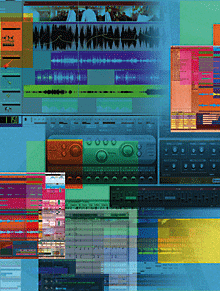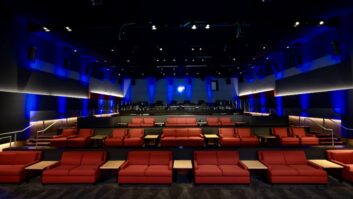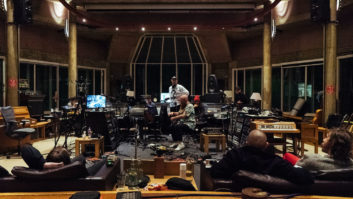
At a recent Grammy Sound Table event in Anaheim, Calif., coinciding with the NAMM convention, the four producer panelists were asked what seemed like a throwaway question about important technology advances and how they fit into their workflow. Harvey Mason Jr. of The Underdogs chimed in right away: The new Intel Macs, he said. This whole new generation of dual and now quad processors. Carmen Rizzo concurred: “The speed is just amazing, and for my live work, the latency is disappearing.” The other two panelists nodded their heads and the panel moved on.
But that simple answer actually spoke volumes about the new means of production. Just a few short years ago, off-loaded host processing was all the rage as a way of freeing up the core CPU to run software without choking the machine. Now, multiple processors in a single Mac or PC have increased processing power and decreased latency. And for a producer like Mason, who averages about a song a day, the speed has absolutely increased his productivity.
These advancements are certainly a boon for music producers, but for developers, they can be a double-edged sword: Yes, there is greater potential to take their software to an even higher level, but there is also great pressure from the audio community to do that as soon as possible.
“The more you can do natively, the more you want to do that way, so users are pushing the limits further,” notes Jason Davies of BIAS. “With more CPU power available, we are able to offer much higher-quality real-time and offline sample rate conversion and more powerful native DSP processing than ever before.”
At the heart of the current wave of native progress is multicore multiprocessors — which combine two or more independent processors into a single package — from companies such as AMD and Intel, the latter of which is currently shipping its Core Duo, Core 2 Duo and Xeon dual-core processors. Intel also recently introduced a quad-core processor, the Core 2 Extreme Q6700, which runs at a speed of 2.66 GHz with 8 MB of L2 cache. The advantage of these processors is that they allow the signal between different chips to travel a shorter distance, meaning that the signal does not degenerate as much, therefore allowing more data to be sent at the same period of time. They are also more power-efficient and take up less space.
“The number of effects and synths you can use at any given time is dependent on the processing power of the machine,” says Michael Hoover, executive VP of products and development for Cakewalk. “The upside is that the faster the processor, the more you can do. The downside is that it’s not a fixed, guaranteed amount — it depends on the project size, content and whatever else you are asking the PC to do at the same time. Depending on the software, different systems will let you know more gracefully than others.
“In the early days of using PCs [Mac or PC], users would exceed the CPU power pretty quickly,” he continues. “Today, the average user can create great-sounding productions without being hindered by the CPU’s capabilities. With the introduction of the multicore, multichip systems, there will be limits, but the limits are so high that few people will be hindered by them. For example, SONAR 6 on 64-bit multicore and dual-processor Intel-based workstation platforms enables outstanding performance for digital audio professionals with improved processing performance and access to eight or more GB of RAM. This will allow musicians to process more of their projects in memory with less data caching to and from their hard drive. Audio and video processes can also perform closer to real time with less latency, which is critical for both audio performance and mixing. And probably most important, the additional access to RAM will enable musicians to use larger, more realistic sample content in their virtual instruments, which will result in richer, fuller, more realistic-sounding music productions.”
So what are the disadvantages of multicore? For end-users, there seem to be very few, but for software developers, it means that they have to go back to the lab to ensure their apps are taking full advantage. “The speed of CPUs directly affects the kinds of innovation we can build into our software,” says Hart Shafer, senior product manager for Adobe Audio. “Some years ago, the advantage was with host processing because the chips were function-built to handle audio processing. Now, however, native applications like Adobe Audition are reaping the benefits of billions of dollars spent by the likes of Intel and AMD, allowing us to dream up features that weren’t possible before.
“There are two main benefits to the user: cost and ease,” Shafer adds. “As computer prices continue to fall, it is most often less expensive to buy a standard computer and just add software than it is to buy and use dedicated hardware. Just as important as the lower cost is the ease of entry. New users are generally much more comfortable buying a standard Dell and running with it than worrying about configuring multiple pieces of hardware.”
At Rain Recording, which builds the Element line of DAWs, taking maximum advantage of today’s native processing power calls for a holistic approach to the entire machine. “The philosophy is one of balanced technology,” explains Bill Paschick, president of Rain Recording U.S. “Many people thought for a long time, ‘If I have the fastest processor, I’ll be the fastest.’ But that’s not true. If the hard drive is two years older, for example, it won’t be able to suck the information off the processor fast enough.”
“Not until the last couple of years, when components started to get more balanced, were we able to unlock the power of true multicore,” adds Robin Vincent, president of Rain Recording UK. “There had to be a convergence of peripheral component viability so they would all work in harmony. The software people had to write instruction sets for the dual-core processors, but they also had to say, ‘What about drive speeds? What about buffer sizes?’ The bottom line is that with the Core 2 Duo, there is now a 40-percent increase in processing power at the hardware level, pre-OS. That means, forget Windows XP, forget the operating system — we now have a 40-percent increase in how the computer thinks.”
On the Mac side, the combination of Intel multicore processors and evolution of hardware has had an equally big impact on those machines’ ability to make the most of native processing. With the Xeon chip now available within the Mac architecture, the G5 has already gone the way of the dinosaur.
“We worked really hard to make native processing and music production work on a dual-core system for some time,” says Alec Little, senior product manager, music and audio marketing for Apple Inc. “We believe we have arrived now, and as a by-product, we have also been able to arrive at a portable solution with the MacBook Pro. The top-of-the-line Mac Pro [tower] has two dual-core Xeon processors, but there are other elements that make it compelling for audio: huge, 16GB RAM capacity and four internal hard drives for up to three terabytes of storage.
“Our previous benchmark for audio performance was the G5 Quad, which had quad processors but older technology,” he continues. “In our Logic DAW, the Sculpture soft synth is a very DSP-intensive instrument. With the G5 Quad, we could have 17 instantiations of Sculpture, whereas in the Xeon we can have 30. The Platinum ‘Verb could have 240 instantiations with the G5 and 420 with Xeon. So with this transition to Intel, the Universal Binary applications, we’ve seen the power of Logic almost double.”
The result of these impressive specs is a boost in native capability that takes another step toward truly intuitive operation. “Improved native processing speeds the workflow, providing a better real-time experience,” explains Dave Chaimson, VP of marketing for Sony Media Software and its ACID Pro, Sound Forge and Vegas programs. “You can instantly hear or see the results of the edits you make or the effects you apply. It also decreases rendering times. We allow for user-customization to tailor for special circumstances, such as rendering other projects in the background or running with several instances of the application open at once.”
Cakewalk’s Hoover reminds users that the ultimate technique for optimizing native processing lies in maintaining a machine dedicated solely to audio. “If someone wants to get the most from their native system, then they really need to dedicate a PC to the task,” he says. “Installing as few things as possible will keep them making music rather than trouble-shooting the system.”
The evolution of native processing may be one of the most important ongoing, behind-the-scenes developments in pro audio as it continues to remove more of the barriers that currently separate human and machine. “Our job is to make sure you forget all about your computer — it should be transparent,” says Rain Recording’s Paschick. “But it’s not about a limitless supply of sounds or effects. It’s about being able to use the instruments and plug-ins you like without having to worry about their effect on the system.”
“With the advances chipmakers like Intel have brought to processing, we are just now starting to realize the benefits,” adds Hoover. “All of this is going to remove, diminish and maybe even eliminate limits to creativity for both the musicians who use our products and for Cakewalk as a developer of products for musicians. Ultimately, this will result in better-sounding music for everyone.”
NATIVE DAWS, AT A GLANCE
David Weiss is Mix’s N.Y. editor.
MEET VISTA
With Microsoft’s latest platform, Vista, now on the market, PC users are wondering if this is a good thing. Cakewalk’s Michael Hoover assures us that it is. “The main performance benefits for DAW users can be attributed to the Multimedia Class Scheduler (MMCSS) and WaveRT implementation in Vista,” he says. “DAW users are aware that streaming low-latency audio comes at the price of CPU consumption. Also, there is a threshold beyond which lower latency can cause glitches in audio playback. To address this long-standing issue, Vista has new features designed to aid real-time streaming multimedia applications. The new MMCSS and WaveRT audio drivers offer applications a more efficient mechanism to stream low-latency audio with a lower CPU hit.”
WaveRT brings high-performance, real-time, low-latency audio drivers designed for pro audio to Vista. “The streaming model for such drivers is somewhat like [Steinberg’s] ASIO and [Windows’ previous driver model] DirectKS, but there are important differences,” says Hoover. “The WaveRT signal flow permits direct access to the internal audio hardware buffers and sample position counters, allowing a DAW application to stream audio to the hardware in the most efficient manner possible. Direct access to buffers and sample position means no costly user-mode-to-kernel-mode transitions on each audio pump cycle. With ASIO and Kernel Streaming [DirectKS WDM drivers], these transitions were unavoidable in Windows XP. This translates into lower CPU consumption while running at very low audio playback latencies.
“Most off-the-shelf Vista-logo machines that will be available in 2007 will ship with onboard audio that is WaveRT-compliant,” he concludes. “This promises low-latency audio playback from even consumer-grade laptops and desktops. When more pro audio vendors make WaveRT drivers available, DAW users will benefit from more efficient low-latency playback.”







